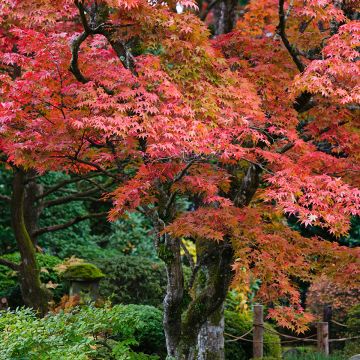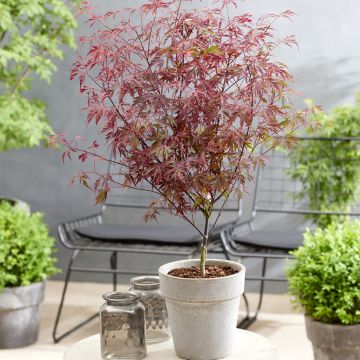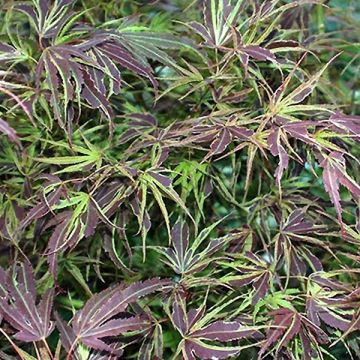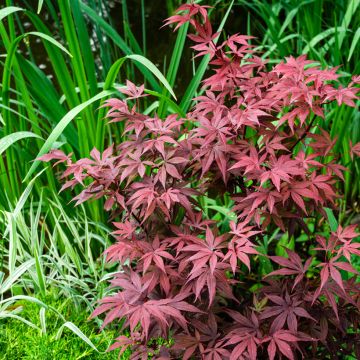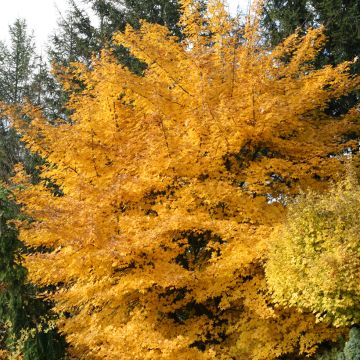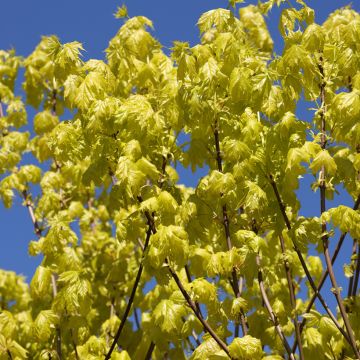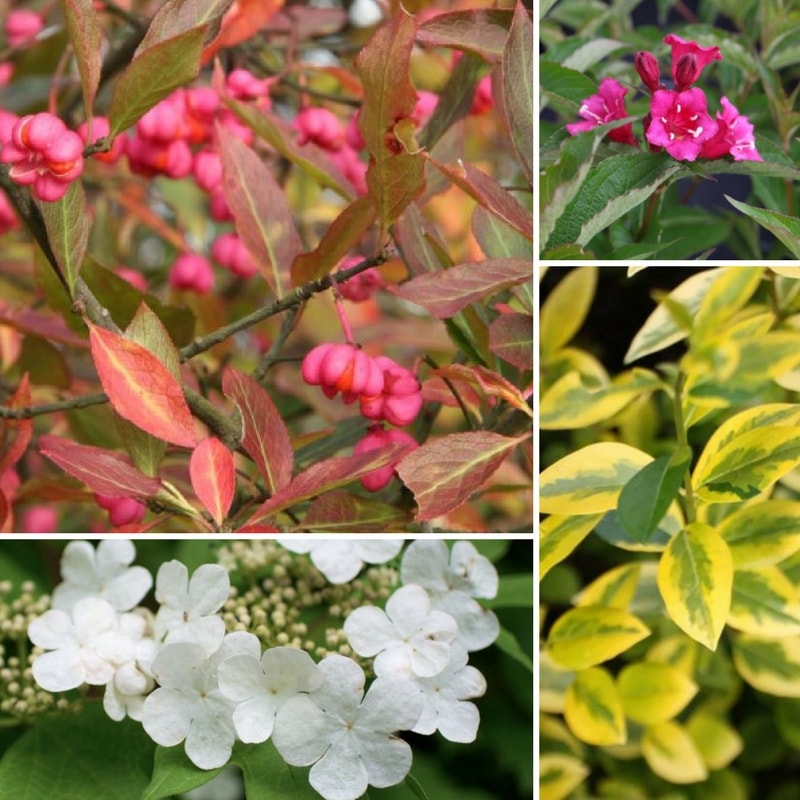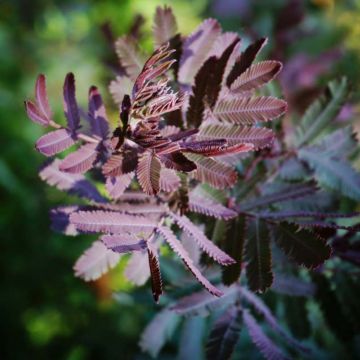

Acer rubrum Green Pillar - Red maple
Acer rubrum Green Pillar - Red maple
Acer rubrum Green Pillar
Red maple, Swamp maple, Water maple
Special offer!
Receive a €20 voucher for any order over €90 (excluding delivery costs, credit notes, and plastic-free options)!
1- Add your favorite plants to your cart.
2- Once you have reached €90, confirm your order (you can even choose the delivery date!).
3- As soon as your order is shipped, you will receive an email containing your voucher code, valid for 3 months (90 days).
Your voucher is unique and can only be used once, for any order with a minimum value of €20, excluding delivery costs.
Can be combined with other current offers, non-divisible and non-refundable.
Why not try an alternative variety in stock?
View all →This plant carries a 24 months recovery warranty
More information
We guarantee the quality of our plants for a full growing cycle, and will replace at our expense any plant that fails to recover under normal climatic and planting conditions.
Does this plant fit my garden?
Set up your Plantfit profile →
Description
Acer rubrum 'Green Pillar' is a variety of red maple that will appeal to enthusiasts of sculptural silhouettes. This small tree has moderate growth and forms a beautiful vegetal column, easy to integrate into even small gardens. While its flowering, which appears before the foliage, remains discreet, its vegetation is quite ornamental, composed of trilobed leaves with a dark green and glossy upper surface. Interestingly, unlike other species, it turns yellow in autumn instead of red, and this very ornamental attire remains on the plant for a long time. This very hardy tree tolerates urban pollution, but not limestone. It should be planted in a sunny location in moist, acidic to neutral soil.
The Acer (Maple) genus gave its name to the former family Aceraceae, now integrated into the Sapindaceae family, alongside ornamental plants such as the classic Koelreuteria or the less common, but very pretty Xanthoceras sorbifolium. There are more than 150 species of Maples, all originating from the northern hemisphere, mostly trees, but also shrubs, such as the charming Japanese Maples. Maples are recognised by their opposite leaves and especially by their double samara fruits, which fall while rotating like helicopter blades. They are all deciduous, except for Acer sempervirens (from Crete) and A. paxii (from China).
Native to eastern North America, Acer rubrum is alternately called Canadian Maple, Red Maple, or Virginia Maple. This tall tree reaches 20 to 30 m in height in the deep soils of its natural habitat. It is fast-growing and forms a straight trunk, with a narrow habit in its early years, broadening with age. It likes humid atmospheres and cool soils and dislikes limestone. It is a forest tree used in cabinetmaking. It is dioecious (there are male and female trees) and it flowers in small dark red clusters before the leaves appear. The 2 cm long fruits ripen as early as June, and their wings form an acute angle between them. The tree is also appreciated in parks and large gardens for its autumn colours that blaze in shades of red.
'Green Pillar' is a Dutch selection, discovered in 1988 by André van Nijnatten in Zundert (more famous, however, for being Van Gogh's birthplace...), cultivated, and then presented at the Plantarium Exhibition in 2001. Noteworthy for several reasons, this variety is easily recognised by its distinctly columnar habit. With moderate growth, this small tree reaches a height of 4 m and a width of 1.50 m ten years after planting, while at maturity, it will not exceed 6 to 8 m, with a slightly loose cylindrical crown of only 2 to 3 m in spread. These limited dimensions make it easy to find a place for it in a small urban garden, especially since it tolerates the atmosphere of cities well. It develops a straight trunk, covered with a fine greyish bark that tends to peel with age. The small, red honey-scented flowers, about 1 cm or less in size, are grouped in clusters and bloom before the appearance of the leaves. The leaves are sometimes slightly tinged with red as they emerge, and spread out to reveal their characteristic trilobed morphology. The edge of the leaf blade is toothed, and its upper part is fairly dark and slightly shiny green. The underside, on the contrary, is matte and lighter, with a slightly whitish colour. Measuring generally 6 to 8 cm in diameter, the leaves are carried by flexible petioles that are almost as long, allowing them to hang down and cover each other when the plant is small.
In autumn, 'Green Pillar' displays another singularity by turning yellow, while most other varieties, as well as the species itself, turn red. This variety is particularly interesting for creating a variegated scene alongside other trees with autumnal colours, especially since the leaves remain on the plant for a long time until frost causes them to fall.
The 'Green Pillar' Maple is particularly well-suited to small gardens, especially in contemporary environments where it is appreciated for its distinctive silhouette. Plant it as a speimen on a lawn or in a group of three, or incorporate it into a diverse flower bed playing with different shapes and foliage colours. Nyssa sylvatica 'Autumn Cascade', a Black Tupelo with trailing branches, offers a colourful festival at the end of the season when its foliage turns purple, red, orange, and bright yellow, perfectly complementing your small Maple. Liquidambar styraciflua 'Gum Ball' is an American Sweetgum that will offer you the same range of autumn colours, but in a more compact form as it forms a 3 m wide ball, which will contrast nicely with the narrow habit of 'Green Pillar'. And to enjoy a play of colours throughout the growing season, not just in autumn, plant a 'Royal Frost' Birch, with its magnificent chocolate-purple foliage, which will contrast beautifully with the dark green of your Maple, and whose white bark will also create a nice contrast in winter with the grey of 'Green Pillar'. Its grey bark will go well with the immaculate white bark of the Himalayan Birch, which appreciates the same soil conditions and will create a beautiful scene in spring and during autumn colouration. In large spaces, the 'Golden Sun' Sweetgum with its yellow spring foliage and crimson autumn colours will create spectacular contrasts of shades.
Plant habit
Flowering
Foliage
Botanical data
Acer
rubrum
Green Pillar
Sapindaceae
Red maple, Swamp maple, Water maple
Cultivar or hybrid
Other Acer - Maple tree
View all →Planting and care
The 'Green Pillar' red maple does not tolerate limestone soils at all, so it should be planted in acidic soil if possible, or at least neutral. In this case, make sure to enrich the planting hole with compost and acidic planting soil (pH 5.5-6) to mix with the existing soil. Soak the container in a bucket for a good quarter of an hour before placing it in the properly sized planting hole (at least 60 cm on all sides). Fill in and water thoroughly afterwards, and ensure that the soil does not dry out during the growing season. Mulching above the root zone will be welcome to maintain soil moisture, as well as regular watering in summer.
Planting period
Intended location
Care
Planting & care advice
This item has not been reviewed yet - be the first to leave a review about it.
Similar products
Haven't found what you were looking for?
Hardiness is the lowest winter temperature a plant can endure without suffering serious damage or even dying. However, hardiness is affected by location (a sheltered area, such as a patio), protection (winter cover) and soil type (hardiness is improved by well-drained soil).

Photo Sharing Terms & Conditions
In order to encourage gardeners to interact and share their experiences, Promesse de fleurs offers various media enabling content to be uploaded onto its Site - in particular via the ‘Photo sharing’ module.
The User agrees to refrain from:
- Posting any content that is illegal, prejudicial, insulting, racist, inciteful to hatred, revisionist, contrary to public decency, that infringes on privacy or on the privacy rights of third parties, in particular the publicity rights of persons and goods, intellectual property rights, or the right to privacy.
- Submitting content on behalf of a third party;
- Impersonate the identity of a third party and/or publish any personal information about a third party;
In general, the User undertakes to refrain from any unethical behaviour.
All Content (in particular text, comments, files, images, photos, videos, creative works, etc.), which may be subject to property or intellectual property rights, image or other private rights, shall remain the property of the User, subject to the limited rights granted by the terms of the licence granted by Promesse de fleurs as stated below. Users are at liberty to publish or not to publish such Content on the Site, notably via the ‘Photo Sharing’ facility, and accept that this Content shall be made public and freely accessible, notably on the Internet.
Users further acknowledge, undertake to have ,and guarantee that they hold all necessary rights and permissions to publish such material on the Site, in particular with regard to the legislation in force pertaining to any privacy, property, intellectual property, image, or contractual rights, or rights of any other nature. By publishing such Content on the Site, Users acknowledge accepting full liability as publishers of the Content within the meaning of the law, and grant Promesse de fleurs, free of charge, an inclusive, worldwide licence for the said Content for the entire duration of its publication, including all reproduction, representation, up/downloading, displaying, performing, transmission, and storage rights.
Users also grant permission for their name to be linked to the Content and accept that this link may not always be made available.
By engaging in posting material, Users consent to their Content becoming automatically accessible on the Internet, in particular on other sites and/or blogs and/or web pages of the Promesse de fleurs site, including in particular social pages and the Promesse de fleurs catalogue.
Users may secure the removal of entrusted content free of charge by issuing a simple request via our contact form.
The flowering period indicated on our website applies to countries and regions located in USDA zone 8 (France, the United Kingdom, Ireland, the Netherlands, etc.)
It will vary according to where you live:
- In zones 9 to 10 (Italy, Spain, Greece, etc.), flowering will occur about 2 to 4 weeks earlier.
- In zones 6 to 7 (Germany, Poland, Slovenia, and lower mountainous regions), flowering will be delayed by 2 to 3 weeks.
- In zone 5 (Central Europe, Scandinavia), blooming will be delayed by 3 to 5 weeks.
In temperate climates, pruning of spring-flowering shrubs (forsythia, spireas, etc.) should be done just after flowering.
Pruning of summer-flowering shrubs (Indian Lilac, Perovskia, etc.) can be done in winter or spring.
In cold regions as well as with frost-sensitive plants, avoid pruning too early when severe frosts may still occur.
The planting period indicated on our website applies to countries and regions located in USDA zone 8 (France, United Kingdom, Ireland, Netherlands).
It will vary according to where you live:
- In Mediterranean zones (Marseille, Madrid, Milan, etc.), autumn and winter are the best planting periods.
- In continental zones (Strasbourg, Munich, Vienna, etc.), delay planting by 2 to 3 weeks in spring and bring it forward by 2 to 4 weeks in autumn.
- In mountainous regions (the Alps, Pyrenees, Carpathians, etc.), it is best to plant in late spring (May-June) or late summer (August-September).
The harvesting period indicated on our website applies to countries and regions in USDA zone 8 (France, England, Ireland, the Netherlands).
In colder areas (Scandinavia, Poland, Austria...) fruit and vegetable harvests are likely to be delayed by 3-4 weeks.
In warmer areas (Italy, Spain, Greece, etc.), harvesting will probably take place earlier, depending on weather conditions.
The sowing periods indicated on our website apply to countries and regions within USDA Zone 8 (France, UK, Ireland, Netherlands).
In colder areas (Scandinavia, Poland, Austria...), delay any outdoor sowing by 3-4 weeks, or sow under glass.
In warmer climes (Italy, Spain, Greece, etc.), bring outdoor sowing forward by a few weeks.






























